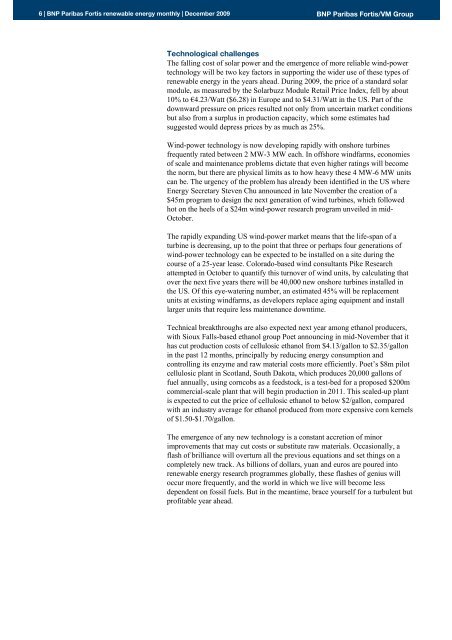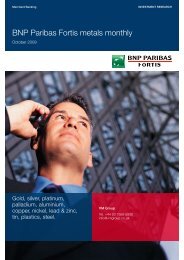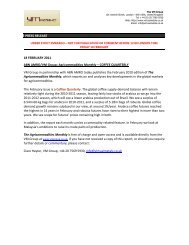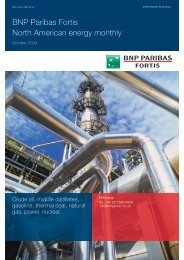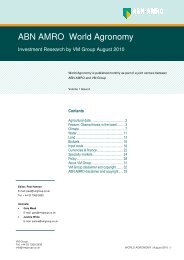BNP Paribas Fortis renewable energy monthly - Virtual Metals
BNP Paribas Fortis renewable energy monthly - Virtual Metals
BNP Paribas Fortis renewable energy monthly - Virtual Metals
Create successful ePaper yourself
Turn your PDF publications into a flip-book with our unique Google optimized e-Paper software.
6 | <strong>BNP</strong> <strong>Paribas</strong> <strong>Fortis</strong> <strong>renewable</strong> <strong>energy</strong> <strong>monthly</strong> | December 2009 <strong>BNP</strong> <strong>Paribas</strong> <strong>Fortis</strong>/VM Group<br />
Technological challenges<br />
The falling cost of solar power and the emergence of more reliable wind-power<br />
technology will be two key factors in supporting the wider use of these types of<br />
<strong>renewable</strong> <strong>energy</strong> in the years ahead. During 2009, the price of a standard solar<br />
module, as measured by the Solarbuzz Module Retail Price Index, fell by about<br />
10% to €4.23/Watt ($6.28) in Europe and to $4.31/Watt in the US. Part of the<br />
downward pressure on prices resulted not only from uncertain market conditions<br />
but also from a surplus in production capacity, which some estimates had<br />
suggested would depress prices by as much as 25%.<br />
Wind-power technology is now developing rapidly with onshore turbines<br />
frequently rated between 2 MW-3 MW each. In offshore windfarms, economies<br />
of scale and maintenance problems dictate that even higher ratings will become<br />
the norm, but there are physical limits as to how heavy these 4 MW-6 MW units<br />
can be. The urgency of the problem has already been identified in the US where<br />
Energy Secretary Steven Chu announced in late November the creation of a<br />
$45m program to design the next generation of wind turbines, which followed<br />
hot on the heels of a $24m wind-power research program unveiled in mid-<br />
October.<br />
The rapidly expanding US wind-power market means that the life-span of a<br />
turbine is decreasing, up to the point that three or perhaps four generations of<br />
wind-power technology can be expected to be installed on a site during the<br />
course of a 25-year lease. Colorado-based wind consultants Pike Research<br />
attempted in October to quantify this turnover of wind units, by calculating that<br />
over the next five years there will be 40,000 new onshore turbines installed in<br />
the US. Of this eye-watering number, an estimated 45% will be replacement<br />
units at existing windfarms, as developers replace aging equipment and install<br />
larger units that require less maintenance downtime.<br />
Technical breakthroughs are also expected next year among ethanol producers,<br />
with Sioux Falls-based ethanol group Poet announcing in mid-November that it<br />
has cut production costs of cellulosic ethanol from $4.13/gallon to $2.35/gallon<br />
in the past 12 months, principally by reducing <strong>energy</strong> consumption and<br />
controlling its enzyme and raw material costs more efficiently. Poet’s $8m pilot<br />
cellulosic plant in Scotland, South Dakota, which produces 20,000 gallons of<br />
fuel annually, using corncobs as a feedstock, is a test-bed for a proposed $200m<br />
commercial-scale plant that will begin production in 2011. This scaled-up plant<br />
is expected to cut the price of cellulosic ethanol to below $2/gallon, compared<br />
with an industry average for ethanol produced from more expensive corn kernels<br />
of $1.50-$1.70/gallon.<br />
The emergence of any new technology is a constant accretion of minor<br />
improvements that may cut costs or substitute raw materials. Occasionally, a<br />
flash of brilliance will overturn all the previous equations and set things on a<br />
completely new track. As billions of dollars, yuan and euros are poured into<br />
<strong>renewable</strong> <strong>energy</strong> research programmes globally, these flashes of genius will<br />
occur more frequently, and the world in which we live will become less<br />
dependent on fossil fuels. But in the meantime, brace yourself for a turbulent but<br />
profitable year ahead.


